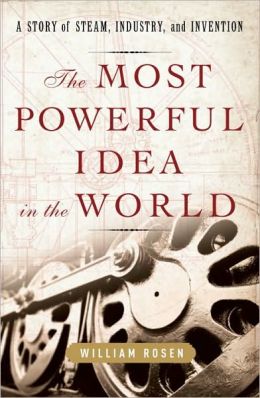Tuesday, March 19, 2013
Rosen on the History of Technology
If you drink from a straw there is clearly a perception that you are sucking up liquid. In fact we know that you are creating a vacuum, and it is the pressure of the atmosphere on the liquid in the glass that is pushing the liquid up the straw.
Newcomen, when he invented his steam engine, had the perception that one could drive a piston in a cylinder if the pressure on one side of the piston was different than that on the other side. If one side of the piston was exposed to the air, air pressure would be applied to that side. Steam pressure applied to the other side could drive the piston towards the end of the cylinder open to the air. By removing the steam and creating a (partial) vacuum, the pressure would be lowered to less than the air pressure and the piston could be returned. Newcomen realized that by condensing the steam in a closed system, he could create that partial vacuum.
His steam engine was good enough to make a lot of money pumping water out of the coal mine that were beginning to fuel England in the early 18th century. They were, unfortunately, very inefficient. It took James Watt to recognize the fact that much more efficient steam engines could be built, to discover the key invention to do so, and to start the commercial development of those improved steam engines.
In his book, The Most Powerful Idea in the World: A Story of Steam, Industry, and Invention, William Rosen describes the inventions of Newcomen and Watt. He describes how each built upon knowledge accumulated by their predecessors. He notes that the 17th century was the time in which the English Royal Society of London for Improving Natural Knowledge was created promoting the dissemination of scientific knowledge, and the Royal Society for the encouragement of Arts, Manufactures and Commerce which promotes the creation and dissemination of technological knowledge.
He also describes the evolution of patent law that provided a profit motive for people to invent new devices with practical applications and profit from their commercialization. That is an interesting story. The kings of England had issued patents giving monopoly power over specific markets to favored subjects. Edward Coke changed English patent law requiring that there be some invention to justify the granting of a patent. (His law also specified the length of a patent's monopoly as 14 years, twice the seven years of the apprenticeships of his time.)
Francis Bacon added the requirement to patents that the invention would have to be publicly disclosed. Thus not only did patents give people economic incentives to invent, but they allowed other inventors quickly to learn about and improve every patented invention. Thus by the end of the 17th century the basis in patent law that was critical for the industrial revolution had been created in England. Rosen identifies patenting in this modern sense as the most powerful idea in the world.
He also describes the development of measurement and quantification, its spread to those seeking to invent. Measurement of latent energy, the dependence of boiling point on atmospheric pressure, and other things was critical to the advance of the steam engine. Indeed, improved measurement was critical to other inventions during the industrial revolution and since.
He also describes the improved linkages between people who worked with their hands and worked for a living and those who lived on income and had created knowledge as an avocation. The artisans became more literate and numerate, and some rose to prominence by their experimental and inventive abilities.
Basically, he describes a significant change in institutions that combined most auspiciously in England in terms of the technological revolution that was part of the industrial revolution.
Labels:
book review,
History,
Innovation,
Technology
Subscribe to:
Post Comments (Atom)

No comments:
Post a Comment